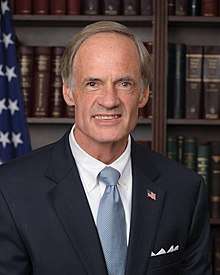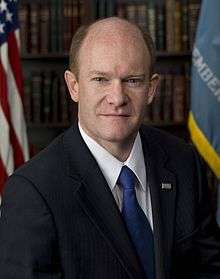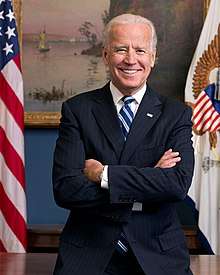Delaware Democratic Party
The Delaware Democratic Party, sometimes referred to as the DelDems is the affiliate of the Democratic Party in the state of Delaware, headquartered in unincorporated New Castle County.
Delaware Democratic Party | |
|---|---|
| Chairperson | Erik Raser-Schramm |
| Headquarters | New Castle, Delaware |
| Ideology | Modern liberalism Third Way |
| National affiliation | Democratic Party |
| Colors | Blue |
| Delaware Senate | 12 / 21 |
| Delaware House of Representatives | 26 / 41 |
| Statewide Executive Offices | 6 / 6 |
| United States Senate | 2 / 2 |
| United States House of Representatives | 1 / 1 |
| County Councils | 16 / 24 |
| Website | |
| www.deldems.org | |
Erik Raser-Schramm is the state Chair. The Delaware Democratic Party is one of the two biggest parties in the state of Delaware (the other being the Republican Party) and has existed since the Jacksonian Democrats broke away from the Federalists in 1825. Besides their most prominent current political figure, former Vice President Joe Biden, the party occupies all federal seats for the state in Congress and currently has majority control over the state legislative and executive branch.
History of the party
Party creation
As the first state of the United States, Delaware was at the forefront of the creation in U.S. political parties. The origins of the Delaware Democratic Party can be traced back to the original anti-federalist party. While key difference divide this part from the Democratic Party today, key issues involving government involvement and ideologies such as Jeffersonian and Jacksonian can be linked to modern day ideals of the Delaware Democratic party.[1] Yet, despite being one of the first states with true parties, the spiritual predecessor of the Democratic party struggled to support its agenda in the state. It wasn't until the splitting of parties into federalists and Jacksonians that the Democratic party got its first true start. With only one bad loss in 1855 to the American Party, the Democratic Party dominated politics up until the end of Reconstruction in the United States.[1] Most fascinating of all, was how the party maintained its popularity during the Civil War. Despite being a northern state, Delaware Democrats opposed the abolition of slavery and named themselves "the white man's party" as they fought the Republican congress during Reconstruction.[1] With 36 years of election dominance, the Democrats eventually fell out of power due to one major factor, the growth of industry in the state.
An era of weakness
Following the ousting of the Democrats in both the federal and state sector, the Republican party remained the dominate party throughout the early 1900s and up until World War II. Even when John Addicks attempted to illegally purchase the Republican seat in the U.S. Senate, the Democrats were unable to capitalize. To emphasize just how far the party had fallen, the seat that Addicks attempted to take lay vacant for four consecutive terms with the Democrats unable to take it despite the clear corrupt actions of the Republican candidate Addicks.[1] From 1897 to 1936, Delaware Democrats were irrelevant in politics with Republicans either dominating the state senate and house of Representatives or the Democrats completely absent from federal politics. With the power of industry overriding agriculture, the Democratic Party was not be able to regain an equal footing in the state until Franklin D. Roosevelt came into office.
Trading time with the Republicans
Following its period of weakness, the Democratic Party of Delaware began to regain an equal foothold with its Republican Rival following World War II. While evidence Republican domination could be still be see in the form of J. Caleb Boggs and John J. Williams, the third member of this "Big Three" was a Democrat named Elbert Carvel. Carvel served two terms as the governor of the state and helped keep his party relevant even when they did not control the state.[1] Despite what occurred in the past, The Democrats of the late 1970s to 2000 held an equal footing in the state, neither party gaining serious ground on the other. Democrats would end up holding the Governor position in the state for 30 years in comparison to their counterparts possession of the position for 29.[1] Even after the Republicans had held the office of the Governor more than 20 years, the Democrats simply took it back and continue to occupy it to this day.
Recent glory
In the past few years, the Democratic Party has risen to become the most popular party in the state of Delaware. The party has control at the state level over the Executive branch and the Legislative branch.
Current elected officials
The following is a list of elected statewide and federal Democratic officeholders beginning in 2019:
Members of Congress
Democrats comprise all of Delaware's 3-member Congressional delegation - including both US Senators and the lone member of the House of Representatives.
U.S. Senate
Democrats have controlled both of Delaware's seats in the U.S. Senate since 2000:
- Class I: Tom Carper (Senior Senator, Ranking Member of Senate Environment Committee)
 Senior Senator Carper
Senior Senator Carper - Class II: Chris Coons (Junior Senator, Vice Chair of Senate Ethics Committee)
 Junior Senator Coons
Junior Senator Coons
U.S. House of Representatives
Democtats have controlled Delaware's lone seat in the U.S. House of Representatives since 2010:
Statewide officials
Democrats control all six statewide elected offices.
- Governor: John Carney
- Lieutenant Governor: Bethany Hall-Long
- Attorney General: Kathy Jennings
- Treasurer: Colleen Davis
- Auditor: Kathy McGuiness
- Commissioner of Insurance: Trinidad Navarro
State legislative leaders
- Senate President: Bethany Hall-Long
- Senate President Pro Tempore: David McBride
- Senate Majority Leader: Nicole Poore
- Speaker of the House: Peter Schwartzkopf
- House Majority Leader: Valerie Longhurst
State Senate
In 2019, Democrats control 13 of the statewide elected offices.[2] State Senators must be citizens of the United State and have resided in Delaware for three years. Candidates must also have been a resident of their respective district for at least one year preceding their election. The age requirement to run for this elected seat is 27 years old.
- 1st Senate District: Harris B. McDowell III
- 2nd Senate District: Darius J. Brown
- 3rd Senate District: S. Elizabeth “Tizzy” Lockman
- 4th Senate District: Laura V. Sturgeon
- 8th Senate District: David Sokola
- 9th Senate District: Jack Walsh
- 10th Senate District: Stephanie Hansen
- 11th Senate District: Bryan Townsend
- 12th Senate District: Nicole Poore
- 13th Senate District: David B. McBride
- 14th Senate District: Bruce Ennis
- 17th Senate District: Charles “Trey” Paradee III
Current makeup of Delaware State Senate
| District | Name | Party | First Elected | Residence | Seat up |
|---|---|---|---|---|---|
| 1 | Harris McDowell III | Dem | 1976 | North Wilmington | 2020 |
| 2 | Darius Brown | Dem | 2018 | East Wilmington | 2022 |
| 3 | S. Elizabeth "Tizzy" Lockman | Dem | 2018 | West Wilmington | 2022 |
| 4 | Laura Sturgeon | Dem | 2018 | Centerville | 2022 |
| 5 | Catherine Cloutier | Rep | 2000 | Heatherbrooke | 2020 |
| 6 | Ernesto Lopez | Rep | 2012 | Rehoboth Beach | 2022 |
| 7 | Anthony Delcollo | Rep | 2016 | Elsmere | 2020 |
| 8 | David Sokola | Dem | 1990 | Newark | 2020 |
| 9 | Jack Walsh | Dem | 2016 | Stanton | 2020 |
| 10 | Stephanie Hansen | Dem | 2017 | Middletown | 2022 |
| 11 | Bryan Townsend | Dem | 2012 | Newark | 2022 |
| 12 | Nicole Poore | Dem | 2012 | Penn Acres | 2020 |
| 13 | David McBride | Dem | 1980 | Hawk's Nest | 2022 |
| 14 | Bruce Ennis | Dem | 2007 | Clayton | 2020 |
| 15 | David Lawson | Rep | 2010 | 2020 | |
| 16 | Colin R. J. Bonini | Rep | 1994 | South Dover | 2022 |
| 17 | Trey Paradee | Dem | 2018 | North Dover | 2022 |
| 18 | David Wilson | Rep | 2018 | Milford | 2022 |
| 19 | Brian Pettyjohn | Rep | 2010 | Georgetown | 2020 |
| 20 | Gerald Hocker | Rep | 1996 | Bethany Beach | 2020 |
| 21 | Bryant Richardson | Rep | 2014 | Laurel | 2022 |
State House of Representatives
In 2011, Democrats control 26 of the 41 statewide elected offices.[3] Any candidate running for the House of Representatives must have lived in Delaware for three years and be a U.S. citizen. The candidate must also live in the district at least one year prior to running for office and be at least 24 years of age.
- 1st Representative District: Dennis Williams
- 2nd Representative District: Stephanie Bolden
- 3rd Representative District: Helene Keeley
- 4th Representative District: Gerald Brady
- 5th Representative District: Melanie George
- 6th Representative District: Debra Heffernan
- 7th Representative District: Bryon Short
- 8th Representative District: S. Quinton Johnson
- 9th Representative District: Rebecca Walker
- 10th Representative District: Dennis Williams
- 13th Representative District: John Mitchell Jr.
- 14th Representative District: Peter Schwartzkopf
- 15th Representative District: Valerie Longhurst
- 16th Representative District: James Johnson
- 17th Representative District: Michael Mulrooney
- 18th Representative District: Michael Barbieri
- 19th Representative District: Robert Gilligan
- 23rd Representative District: Teresa Schooley
- 24th Representative District: Edward Osienski
- 25th Representative District: John Kowalko, Jr.
- 26th Representative District: John Viola
- 27th Representative District: Earl Jaques, Jr.
- 28th Representative District: William Carson, Jr.
- 31st Representative District: Darryl Scott
- 32nd Representative District: E. Bradford Bennett
- 41st Representative District: John Atkins
Current make-up of Delaware House of Representatives
| District | Name | Party | First Elected | Residence |
|---|---|---|---|---|
| 1 | Dennis Williams | Dem | 1996 | Wilmington North |
| 2 | Stephanie Bolden | Dem | 2010 | |
| 3 | Helene Keeley | Dem | 1996 | Wilmington South |
| 4 | Gerald Brady | Dem | 2006 | Wilmington West |
| 5 | Melanie George | Dem | 2002 | Bear/Newark |
| 6 | Debra Heffernan | Dem | 2010 | |
| 7 | Bryon Short | Dem | 2007 | |
| 8 | S. Quinton Johnson | Dem | 2008 | Middletown |
| 9 | Rebecca Walker | Dem | 2010 | |
| 10 | Dennis Williams | Dem | 2008 | Talleyville |
| 11 | Gregory Lavelle | Rep | 2000 | Sharpley |
| 12 | Deborah Hudson | Rep | 2000 | Fairthorne |
| 13 | John Mitchell Jr. | Dem | 2006 | Elsmere |
| 14 | Peter Schwartzkopf | Dem | 2002 | Rehoboth |
| 15 | Valerie Longhurst | Dem | 2004 | Bear |
| 16 | James Johnson | Dem | 2002 | Jefferson Farms |
| 17 | Michael Mulrooney | Dem | 1998 | Pennwood |
| 18 | Michael Barbieri | Dem | 2008 | Newark |
| 19 | Robert Gilligan | Dem | 1972 | Sherwood Park |
| 20 | Nick T. Manolakos | Rep | 2006 | Limestone Hills |
| 21 | Michael Ramone | Rep | 2008 | Drummond Hill |
| 22 | Joseph Miro | Rep | 1998 | Pike Creek Valley |
| 23 | Teresa Schooley | Dem | 2004 | Newark |
| 24 | Edward Osienski | Dem | 2010 | |
| 25 | John Kowalko, Jr. | Dem | 2006 | Newark South |
| 26 | John Viola | Dem | 1998 | Newark |
| 27 | Earl Jaques, Jr. | Dem | 2008 | Glasgow |
| 28 | William Carson, Jr. | Dem | 2008 | Smyrna |
| 29 | Lincoln Willis | Rep | 2010 | |
| 30 | William Outten | Rep | 2004 | Harrington |
| 31 | Darryl Scott | Dem | 2008 | Dover |
| 32 | E. Bradford Bennett | Dem | 2008 | Dover |
| 33 | Harold Peterman | Rep | 2010 | |
| 34 | Donald Blakey | Rep | 2006 | |
| 35 | David Wilson | Rep | 2008 | Bridgeville |
| 36 | Harvey Kenton | Rep | 2010 | |
| 37 | Ruth Briggs King | Rep | 2009 | Georgetown/Lewes |
| 38 | Gerald Hocker | Rep | 2002 | Ocean View |
| 39 | Daniel Short | Rep | 2006 | Seaford |
| 40 | Clifford "Biff" Lee | Rep | 2000 | Laurel |
| 41 | John Atkins | Dem | 2008 (2003–2006) | Millsboro |
Federal Executive Officials

In the 2008 U.S. Presidential election, Senator Joe Biden was elected Vice President of the United States alongside Illinois Senator Barack Obama, who was elected President of the United States. Biden is the first Delawarean to run on a presidential ticket, and the first Delawarean to be elected and hold the office. Biden assumed the Vice Presidency on January 20, 2009 and served until January 20, 2017.
See also
References
- Boyer, William and Edward C. Ratledge. Delaware Politics and Government. Board of Regents of the University of Nebraska. 2009.
- Delaware State Senate Home,http://legis.delaware.gov/Legislature.nsf/Lookup/SenateHome?open&nav=senate, Accessed November 15th, 2011
- Delaware House of Representatives,http://legis.delaware.gov/Legislature.nsf/Lookup/House_Home?open&nav=house, accessed November 15, 2011